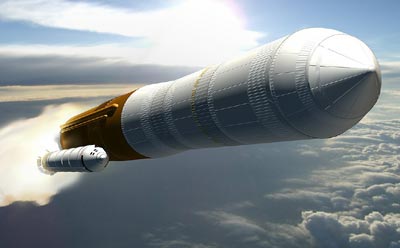Rocket to nowhereby Lou Friedman
|
| The United States now has four possible paths to Earth orbit: Atlas 5, Delta 4, Falcon 9, and the Russian Soyuz. All are available at lower costs than the shuttle. |
Eric Sterner, a very experienced military and civil space analyst now at the Marshall Institute in Washington, DC, told Wired News earlier this month, “In theory, [having both EELVs and Falcon 9] would be a good thing, increasing competition and giving DoD greater access to space. In practice, it may not be as easy as all that. DoD poured a lot of money into the EELV and has much more control over it than SpaceX’s Falcon 9. It may be reluctant (for both legitimate and illegitimate reasons) to make greater use of Falcon since that would mean less use of EELV, which it’s still on the hook to maintain,” presumably for reasons of national security.
We might find that the US is suddenly rocket-rich. Atlas 5 and Delta 4 can also be developed for cargo and human space flight to low Earth orbit, and—together with Dragon, Orion, Orbital’s recently proposed space plane, and Sierra Nevada’s Dream Chaser—might open up competition for travel to low Earth orbit. Such resiliency will certainly add to national security, and the competition might even drive down prices. The United States now has four possible paths to Earth orbit: Atlas 5, Delta 4, Falcon 9, and the Russian Soyuz. All are available at lower costs than the shuttle.
Is this a dream come true? Or is there a nightmare looming as we fall asleep?
Right in the middle of all this opportunity, the US Congress has decided that not enough money is being spent. It is mandating, apparently against the wishes of NASA and the Administration and without interest from any potential user, building a new launch vehicle by 2016—an overly optimistic, earlier-than-needed date. It appears that the result of the fiscal year 2011 budget deliberations in Congress will be to mandate for NASA to begin development of a rocket capable of delivering 130 metric tons to orbit, and prescribing that it uses the shuttle core stage and solid rocket motors.
But who is the customer? What are the requirements? What is the mission? If we have, or soon will have, four ways to get humans to low Earth orbit already, isn’t that enough for the present? Heavy-lift capability isn’t needed until we have heavy-lift requirements. Starting down the development path before those requirements are defined is a textbook prescription for wasting money. Not only will money be wasted, but it will undermine the existing Air Force and commercial options. America might repeat the perilous mistake of 1979–80: putting all human-to-space eggs in one not-yet-built basket.
| The space community has been flimflammed many times with unsustainable program start-ups. In my view, the Congressional rush to define a heavy-lift vehicle without a mission will almost certainly join that list. |
I am as much of a space enthusiast as anyone. I very much want a deep space rocket and I want it to take humans out of Earth orbit into the solar system. I want huge telescopes, big asteroid missions, and big Mars ventures. But, those missions are not even being considered before the 2020s, so do we need to develop a launch vehicle for them five to ten years before we can use it? The resultant long, drawn-out schedule is another textbook prescription for wasting money.
What is Congress thinking? Are they really planning to accelerate human missions beyond Earth orbit? They did not mention that in their legislation. In fact, they were weaker on that subject than was the Administration. They are more likely thinking only about the next year—the usual political run-up to elections and short-term benefits. Given the current forces for budget-cutting and debt reduction, that will lead to an unsustainable program like Constellation.
The space community has been flimflammed many times with unsustainable program start-ups. The shuttle decision was just such a program. It was a great technical achievement that nonetheless ended human space exploration (and almost ended robotic exploration as well due to the financial burden). X-33, the National Aerospace Plane, and Prometheus nuclear propulsion in the robotic program were other unsustainable, counterproductive programs. In my view, the Congressional rush to define a heavy-lift vehicle without a mission will almost certainly join that list.
SpaceX’s accomplishment was fantastic, from the launch pad where they whittled away cracked nozzle edges to the pinpoint landing. In addition, they quietly delivered a few Cubesat payloads to orbit. Others are in the wings. The aforementioned Orbital and Sierra Nevada should be players, and Lockheed Martin has even suggested they could do a human asteroid mission with Atlas 5 and Orion within a decade. We have good pieces and time to start building the architecture and specifying the requirements and technology for a deep-space rocket. Let’s now take a deep breath and work seriously on this issue for one year before starting a rocket that will go nowhere.
